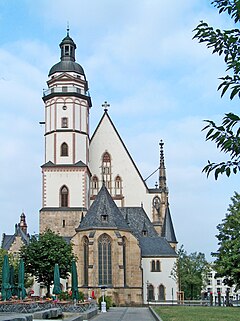Weimar, Arnstadt, and Mühlhausen (1703–08)

Portrait of the young Bach (disputed).[20]
Despite strong family connections and a musically enthusiastic employer, tension built up between Bach and the authorities after several years in the post. Bach was dissatisfied with the standard of singers in the choir, while his employer was upset by his unauthorised absence from Arnstadt; Bach was gone for several months in 1705–06, to visit the great organist and composer Dieterich Buxtehude and his Abendmusiken at St. Mary's Church in the northern city of Lübeck. The visit to Buxtehude involved a 450-kilometre (280 mi) journey each way, reportedly on foot.[24]
In 1706, Bach applied for a post as organist at the Blasius Church (also known as St Blasius or as Divi Blasii) in Mühlhausen.[25][26] As part of his application he had a cantata performed on Easter, 24 April 1707, likely an early version of his Christ lag in Todes Banden.[27] A month later Bach's application was accepted and he took up the post in July.[25] The position included a significantly higher remuneration, improved conditions, and a better choir. Four months after arriving at Mühlhausen, Bach married Maria Barbara Bach, his second cousin. Bach was able to convince the church and town government at Mühlhausen to fund an expensive renovation of the organ at the Blasius Church. In 1708 Bach wrote Gott ist mein König, a festive cantata for the inauguration of the new Council, which was published at the Council's expense.[15]
Return to Weimar (1708–17)

Bach's autograph of the first movement of the Sonata No. 1 in G minor for solo violin (BWV 1001) –  Audio.
Audio.
For more details on this topic, see Erschallet, ihr Lieder, erklinget, ihr Saiten! BWV 172 § Background.
In 1708, Bach left Mühlhausen, returning to Weimar this time as organist and from 1714 Konzertmeister (director of music) at the ducal court, where he had an opportunity to work with a large, well-funded contingent of professional musicians.[15] Bach and his wife moved into a house close to the ducal palace.[28] Later the same year, their first child, Catharina Dorothea, was born, and Maria Barbara's elder, unmarried sister joined them. She remained to help run the household until her death in 1729. Three sons were also born in Weimar: Wilhelm Friedemann, Carl Philipp Emanuel and Johann Gottfried Bernhard. Johann Sebastian and Maria Barbara had three more children who however did not live to their first birthday, including twins born in 1713.[29]Bach's time in Weimar was the start of a sustained period of composing keyboard and orchestral works. He attained the proficiency and confidence to extend the prevailing structures and to include influences from abroad. He learned to write dramatic openings and employ the dynamic motor rhythms and harmonic schemes found in the music of Italians such as Vivaldi, Corelli, and Torelli. Bach absorbed these stylistic aspects in part by transcribing Vivaldi's string and wind concertos for harpsichord and organ; many of these transcribed works are still regularly performed. Bach was particularly attracted to the Italian style in which one or more solo instruments alternate section-by-section with the full orchestra throughout a movement.[30]
In Weimar, Bach continued to play and compose for the organ, and to perform concert music with the duke's ensemble.[15] He also began to write the preludes and fugues which were later assembled into his monumental work The Well-Tempered Clavier (Das Wohltemperierte Klavier—"Klavier" meaning clavichord or harpsichord),[31] consisting of two books, compiled in 1722 and 1744,[32] each containing 24 preludes and fugues in every major and minor key.
Also in Weimar Bach started work on the Little Organ Book, containing traditional Lutheran chorales (hymn tunes) set in complex textures. In 1713, Bach was offered a post in Halle when he advised the authorities during a renovation by Christoph Cuntzius of the main organ in the west gallery of the Market Church of Our Dear Lady. Johann Kuhnau and Bach played again when it was inaugurated in 1716.[33][34]
In the spring of 1714, Bach was promoted to Konzertmeister, an honour that entailed performing a church cantata monthly in the castle church.[35] The first three cantatas Bach composed in Weimar were Himmelskönig, sei willkommen, BWV 182, for Palm Sunday, which coincided with the Annunciation that year, Weinen, Klagen, Sorgen, Zagen, BWV 12, for Jubilate Sunday, and Erschallet, ihr Lieder, erklinget, ihr Saiten! BWV 172 for Pentecost.[36] Bach's first Christmas cantata Christen, ätzet diesen Tag, BWV 63 was premiered in 1714 or 1715.[37][38]
In 1717, Bach eventually fell out of favour in Weimar and was, according to a translation of the court secretary's report, jailed for almost a month before being unfavourably dismissed: "On November 6, [1717], the quondam concertmaster and organist Bach was confined to the County Judge's place of detention for too stubbornly forcing the issue of his dismissal and finally on December 2 was freed from arrest with notice of his unfavourable discharge."[39]
Köthen (1717–23)
Despite being born in the same year and only about 130 kilometres (81 mi) apart, Bach and Handel never met. In 1719, Bach made the 35-kilometre (22 mi) journey from Köthen to Halle with the intention of meeting Handel, however Handel had left the town.[42] In 1730, Bach's oldest son Wilhelm Friedemann travelled to Halle to invite Handel to visit the Bach family in Leipzig, but the visit did not come to pass.[43]
On 7 July 1720, while Bach was away in Carlsbad with Prince Leopold, Bach's wife suddenly died.[44] The following year, he met Anna Magdalena Wilcke, a young, highly gifted soprano sixteen years his junior, who performed at the court in Köthen; they married on 3 December 1721.[45] Together they had thirteen more children, six of whom survived into adulthood: Gottfried Heinrich; Elisabeth Juliane Friederica (1726–81), who married Bach's pupil Johann Christoph Altnickol; Johann Christoph Friedrich and Johann Christian, who both, especially Johann Christian, became significant musicians; Johanna Carolina (1737–81); and Regina Susanna (1742–1809).[



No comments:
Post a Comment